Custom Dashboards
JAMS includes a variety of preinstalled Dashboards that are intended meet most user needs. Users are recommended to use preinstalled Dashboards before attempting to create custom dashboards, in order to gain an understanding of what kinds of data are important and what could potentially be added to enhance a dashboard for the given organization.
JAMS comes with powerful design features to modify or completely alter a Dashboard to fit the way you use JAMS. Custom Dashboards can incorporate a variety of data sources including: JAMS specific data, PowerShell scripts, and data stored in external databases - such as Microsoft SQL Server, MySQL, and Microsoft Access.
There are three key steps to building a custom Dashboard:
- Defining a Data Source (using JAMS or external data sources).
- Setting up a Dashboard Item (determining the Dashboard's functionality and formatting.
- Adding or modifying Parameters, setting up drill downs, filtering functionality.
Follow the steps below to build your own custom Dashboard using JAMS' powerful Dashboard Designer feature.
Defining a Data Source
The process of setting up a custom Dashboard begins by opening the Dashboard Designer and locating and defining a Data Source. Custom Dashboards can incorporate a variety of data sources that can be used to build simple or complex Dashboards.
- Select the Dashboard Designer shortcut from the menu. The Dashboard Designer window will open.
- Select the Data Source tab, then select New JAMS Data Source. The Save Dashboard File dialog will open.

- Enter a name for the Dashboard file (.jdb) and click Save. The Add a Dashboard Data Source Wizard will open.
- Enter a Data Source Name and use the dropdown to select a Data Source Type.

Data Source Description History Provides JAMS history query that returns all JAMS Job Properties matching a specific criteria and time frame. Completions by Severity Includes an optimized version of the History data source that only returns completion count data. This is the preferred choice when retrieving historical data for a large number of jobs. Queue Name Contains all the properties from defined JAMS Queues. Resource Name Incorporates comprehensive information about each JAMS resource, including usage data. Agent Name Provides comprehensive information for all installed JAMS Agents. PowerShell Runs a PowerShell script. The returned PowerShell objects are accessible to all Dashboard items. - Click Next. The Parameters Wizard opens.
- Enter parameters as desired. Note that parameter options are dependent upon the data source selected. Wildcards may be used in the parameter options.
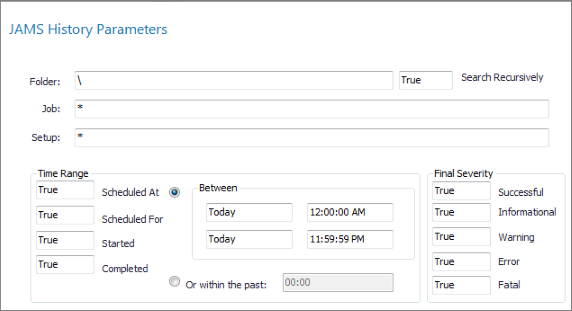
- With the parameters defined as desired, click the Finish button.
Using External Data Sources
Users may use non-JAMS data sources for dashboards, such as a database or XML files. To add an external data source, follow these steps:
- On the Dashboard Designer, select the Data Source tab.
- Select the New External Data Source.NOTE: is different than the New JAMS Data Source button used in the previous section.
- The Create Data Source Wizard opens.
- Select a Data Source Type from the available options, then click Next. (Database, Olap, CSV, Data extract)
- Based on the Data Source Type, either Define the Database Connection, Define the OLAP cube connection, Select the CSV file, or Select the Data Extract, then click Next.
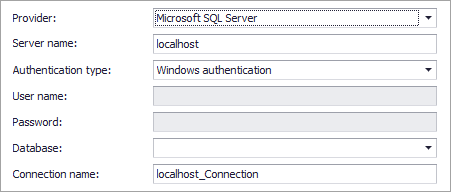 NOTE: Additional configuration settings may be required, based on the Data Source Type.
NOTE: Additional configuration settings may be required, based on the Data Source Type. - With all settings configured, click Finish to display the external data source in the dashboard designer.
Setting up a Dashboard Item
Once a Data Source has been defined, the next step is to set up the Dashboard item(s).
- Begin this step by opening the Designer’s Home tab and select a Dashboard Item type on the Ribbon.

- This action opens the Dashboard Elements page made up of three contiguous sections: Data Source Browser, Data Items Pane and Preview Pane. This is the display where you link (or bind) the data source created in the first step with the new Dashboard Item.
- On the top of the Data Source Browser select an existing Data Source from the drop down menu.
- As shown below, the selected Data Source opens displaying all associated Data Fields.
- Drag the desired Data Field from the Data Source Browser and drop it onto the appropriate container field on the Data Items pane.
 NOTE: You can also remove the data item by dragging it outside the Data Items pane.
NOTE: You can also remove the data item by dragging it outside the Data Items pane. - Use the Preview Pane to confirm each selection.
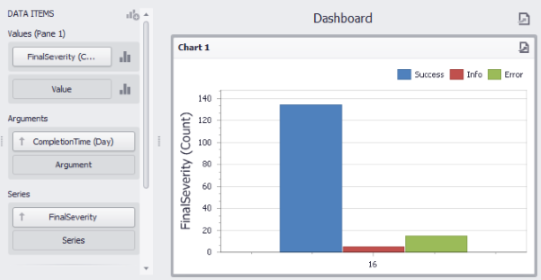 NOTE: You can quickly change the Dashboard type by right-clicking in the Preview pane. This action opens the Dashboard context menu. Select the Convert To command submenu to view a listing of Dashboard types, such as Pivot, Grid, Chart, or Pies.
NOTE: You can quickly change the Dashboard type by right-clicking in the Preview pane. This action opens the Dashboard context menu. Select the Convert To command submenu to view a listing of Dashboard types, such as Pivot, Grid, Chart, or Pies. - You can insert additional Dashboard items by selecting another Dashboard type on the Designer’s Home tab ribbon.NOTE: You can only use one Data Source per Dashboard Item.
- As shown in step 3, open an existing Data Source from the Data Source Dropdown menu and drag and drop the desired Data Fields to the appropriate section on the Data Item Pane.
- From the Design tab, use the available tools to customize the new Dashboard item.
.png)

- Click Save to complete the design process.

Modifying Parameters
Parameters pass information to Dashboard Items, allowing you to alter what is displayed.
Changing an Existing Parameter
To access the parameters settings click the Parameters button (icon with document and gears located on the top right portion of the Dashboard Design pane). This action opens the Parameters dialog.


Creating New Parameters
You can define new parameters within a Dashboard to further customize its display.
To add a parameter(s) to a Dashboard, open the Dashboard Designer.
- On the Dashboard Designer’s Home tab click Open and navigate to the desired Dashboard (.jdb) file, typically located in the JAMS Installation directory (MVPSI/JAMS/Client).
- On the Home tab, click the Parameters button. (located in the Dashboard section of the ribbon bar).

- The Parameters Properties dialog opens. On the left panel select an existing parameter to modify its properties, or click the Add button to define a new parameter.
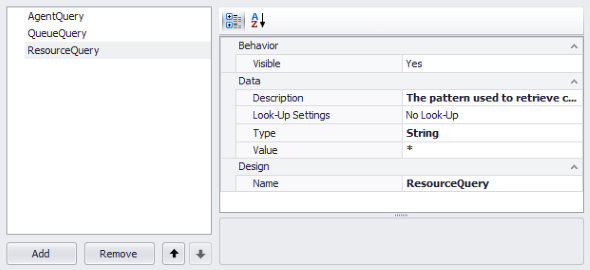
- In the right panel, define the properties for the selected parameter.
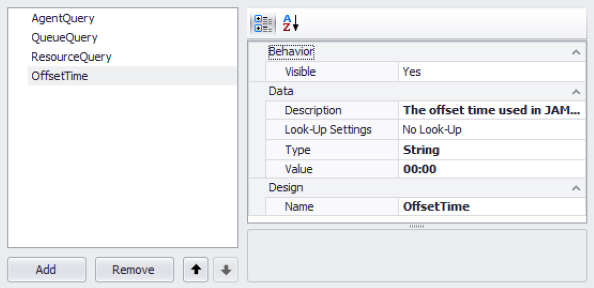
- Click the OK button when completed.
Using the New Parameter
The value of Dashboard parameters can be used for any JAMS Data Source Parameter. This is done using the syntax $parameterName. For example, if you had a parameter called OffsetTime you would reference the Dashboard parameter in a JAMS Completion by Severity data source by entering $OffsetTime into the wizard instead of hard coding a number into the Time Offset field.
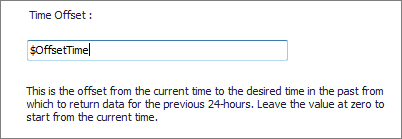
Setting up a Drill-Down Display
The Dashboard Designer includes a drill down function to help you create a more dynamic display with multiple levels of information.
The example below shows how selecting a single node on 24 hour line graph zooms the information view to a particular hour.
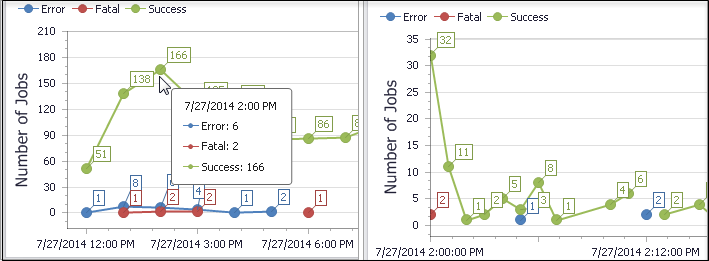
To create a drill down effect you must define multiple related data sets in the Arguments container field located on the Data Items pane. The Dashboard’s highest level data is entered on the first Data Item Container field and the “drill down” data is defined on the second.
A Drill Down Example in 3 Steps
Use the following example to create a pie chart that displays JAMS Jobs that have executed over the past 24 hours by severity levels, such as Success, Warning, Error, Fatal and Informational.
Step 1: Set up the Custom Dashboard Item
To get started with this example, first create a Data Source.
- From the Menu, open the Dashboard Designer.
- On the Data Source tab select the New JAMS Data Source button located on the left end of the Ribbon.
- The Add Dashboard File dialog opens.
- On the first wizard page enter a Data Source Name. For this example, name it JAMS History and use the pull down menu to select a Data Source Type. Choose the History option, which tells JAMS to provide information on previously run Jobs. Select the Next button.
- On the Parameters page, keep the default settings and click the Finish button.
Step 2: Add a Custom Dashboard Item
- From the Dashboard Designer, select the Home tab. On the Ribbon, choose the Pies option.

- This action opens the Dashboard Elements page. This is where you bind specific Data Items to create the pie chart.
- From the Data Source Browser, use the pull-down menu to select the JAMS History Data Source you defined in step 4. This action displays all Data Fields associated with the data source.

- On the Data Source Browser drag and drop the specific Data Fields to the appropriate Data Item Containers on the Data Items pane, as described below.
- Find and then drag the FinalSeverity Data Field to the first Values Data Item Container.
- Second, drag the same FinalSeverity item again, this time to the first Arguments container field. These data items will appear in the top level display as shown in the preview window below.
- To add the data item for the drill down view, drag the JobName data item to the second Argument container.

Step 3: Define and configure the Drill down Property
- On the Dashboard Designer, select the Data tab.
- Activate the Arguments button. By enabling the Arguments option the Dashboard item treats the two arguments as distinct, but related data sets.
- Click to activate (highlight) the Drill Down button. This allow the Dashboard Designer to interpret different sets of data between the two Arguments data item containers.

- On the Preview pane, test the drill down by clicking on the Success portion of the pie chart. This actions should now detail all successful Jobs executed during the past 24 hours.

- To move back to the first level pie chart display, right-click on the chart to display the Drill up context menu or alternatively choose the curved arrow Drill up icon.

- Select the other elements of the pie chart to test the drill down function.
- Optionally, open the Design tab to take advantage of the built-in formatting tools.
- Choose the Save button to save the designed custom Dashboard.
Using the Master Filter
The Master Filter is a Dashboard Designer feature that allows you to choose what data is displayed on a Dashboard Item. For example, when Master Filtering is enabled you can click a specific Dashboard Item to trigger updates to other items, such as chart, pies, or gauges.
The Dashboard example below uses the Master Filter to control what data is displayed in the donut graph in the Preview panel. In this case, the donut graph is linked to the Agent Selection and Date Range items. Making changes to either element, by highlighting one or more agents or changing the date range slider, immediately updates the graph to reflect the changing input data.
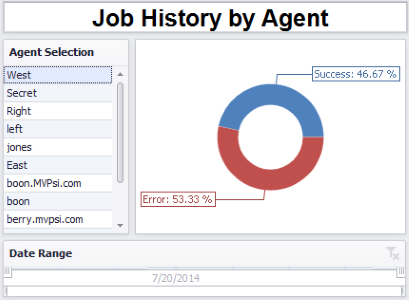
Using Master Filter Modes
For each Dashboard Item, the Master Filter supports two selection modes: Multiple and Single.
Multiple Master Filter Mode
This mode allows you to select multiple elements within a Dashboard subpanel. For example, when choosing the Agent Selection subpanel with the Multiple Master Filter enabled you can Control + click to highlight multiple agents as shown in the two screenshots below.
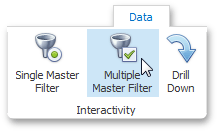

Single Master Filter Mode
Unlike the Multiple Master Filter, the Single Master Filter mode only allows you to select one element at a time within a selected Dashboard subpanel.
Ignoring the Master Filter
Dashboard items can be set to ignore the Master Filter entirely. To do this, choose a Dashboard Item and select the Ignore Master Filters button located on the Dashboard Designer’s Data tab.
For example, the Agent Selection sub panel, shown above, is set to ignore the master filter because it is the primary setting for that subpanel. In other words, you input an agent selection in order to update the donut graph, not the other way around.
Enabling the Master Filter
As described above, there are several Master Filter modes and settings, but there is no one place where you can actually view all these settings. Instead, each individual Dashboard Item must be selected within the Designer to view the Master Filter settings.
However, you can view the Master Filter state by hovering over the filter icon adjacent to the Dashboard title. This filter icon only appears when there is more than one criteria affecting the filter.
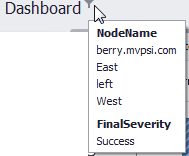
The Dashboard Title is turned off by default on the primary Dashboard. To change this settings open the Designer and select the Home tab. On the far right side of the Ribbon select the Title button. On the Dashboard Title dialog, activate the Visible and Show Master Filter state checkboxes.

Finally, to make changes to a Dashboard’s Master Filter settings, open the Dashboard Designer.
- On the Designer’s Home tab click the Open button.
- Navigate to and select the desired Dashboard (.jdb) file.
- This opens the multi-panel Dashboard Elements page.
- Select the Data tab to view what, if any, Master Filter buttons are activated.
- On the Preview pane, select a subpanel. Notice how the Data Item Container fields are updated to reflect the subpanel’s settings. This is where you define or modify how each Dashboard Item affects the Master Filter.
